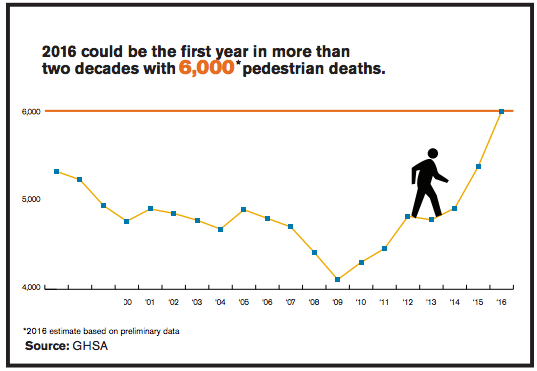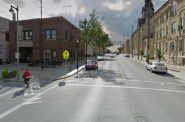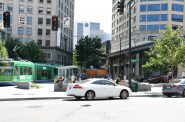The Rise in Pedestrian Deaths
Repeated deaths at same intersections suggest design changes needed.

If America is going to turn this around, the people who design streets and transportation systems will have to accept responsibility. Graph: GHSA
A report on America’s rising pedestrian death toll released by the Governors Highway Safety Association [PDF] estimates that about 6,000 people were killed while walking last year — the highest number in two decades. That’s a 22 percent increase over just two years, significantly higher than the overall increase in traffic deaths.
In Wisconsin, final figures for 2016 aren’t available, but pedestrian deaths are up since 2009, when the total was 35, to 42 in 2014 and 55 in 2015.
The GHSA notes that vehicle safety technology has improved quite a bit in recent decades, reducing fatalities for drivers, while pedestrians have no such advantage.
Instead, America’s traffic safety establishment has long been focused on “behavioral” explanations for traffic deaths — things like seatbelt usage and drunk driving. And that makes sense, to a point: Government interventions to promote seatbelts and discourage driving under the influence have made driving safer.
But the limitations of that approach are all too apparent as America continues to fall further behind other nations on traffic safety. Countries that have made it a priority to limit motorist speed in crowded places are faring much better than we are. Tens of thousands of lives would be saved each year if the U.S. achieved a safety record comparable to nations like the UK, Germany, or Japan.
For the state DOTs that shape streets and transportation policy, there must be something comforting in the behavioral explanations. By ignoring the role of the high-speed, car-centric transportation systems they’ve created, they don’t have to face their own culpability. They are absolved every time a report comes out on rising pedestrian deaths and the news cycle responds with a round of stories about “distracted walking.”
The National Complete Streets Coalition’s Emiko Atherton recently wrote that this focus on cell phones is dangerous:
We know street design is part of this problem because there are patterns to where fatal collisions occur. Heat maps of pedestrian fatalities show that pedestrians are struck and killed by cars at the same intersections and along the same corridors over and over again. Are people using cell phones more in these locations? I doubt it. Street design plays a clear role.
There are plenty of transportation engineers fighting for safer street design. Engineers Peter Furth and Ian Lockwood, for instance, cities should make pedestrian safety and convenience, not traffic movement, a higher priority. Several city DOTs are starting to prioritize walking and biking in their official practice as well. But this attitude has yet to penetrate the core institutions of the American engineering establishment.
At the obscure but influential National Committee on Uniform Traffic Control Devices, which shapes the street design standards followed by engineers around the country, change comes very slowly.
When Streetsblog talked to committee chair Lee Billingsley a few weeks ago, he said the group had no plans to shift course in response to rising fatalities. He insisted that rules governing pedestrian signal timing, for instance, “have stood the test of time,” even as America’s pedestrian safety record has deteriorated.
How many people will die before the traffic safety establishment does some soul searching about the systems they’ve designed and starts reforming practices that have needlessly put people at risk?
Story by Angie Schmitt with additional contributions from Urban Milwaukee. A version of this story originally ran on Streetsblog. Angie Schmitt is a newspaper reporter-turned planner/advocate who manages the Streetsblog Network from glamorous Cleveland, Ohio. She also writes about urban issues particular to the industrial Midwest at Rustwire.com.
Streetsblog
-
Car Culture Cements Suburban Politics
![Sprawl. Photo by David Shankbone (David Shankbone) [GFDL (http://www.gnu.org/copyleft/fdl.html) or CC-BY-SA-3.0 (http://creativecommons.org/licenses/by-sa/3.0/)], via Wikimedia Commons [ https://commons.wikimedia.org/wiki/File%3ASuburbia_by_David_Shankbone.jpg ]](https://urbanmilwaukee.com/wp-content/uploads/2017/10/1024px-Suburbia_by_David_Shankbone-185x122.jpg) Nov 23rd, 2018 by Angie Schmitt
Nov 23rd, 2018 by Angie Schmitt
-
Most Drivers Don’t Yield to Pedestrians
 Mar 22nd, 2018 by Angie Schmitt
Mar 22nd, 2018 by Angie Schmitt
-
Jobs Up Yet Driving Down in Seattle
 Feb 22nd, 2018 by Angie Schmitt
Feb 22nd, 2018 by Angie Schmitt






















I guess that the DOTs haven’t seen any of Urban Milwaukee’s suggestions for improving intersections. Just add some turn lanes, eliminate parking, and make sure to use plenty of green paint to show the cyclists they’re welcome too. Oh wait, that’s the same play that the DOTs have been using since the 1950’s sans the green paint.
Easily dismissing “distracted walking” is going a bit far in the willful disregard of a logical explanation. Smart phone use has seen a steady increase in users during the same time period as the rise in pedestrian deaths. Have streets seen a similar rise in design changes during that time? I don’t think so…
So now we have to redesign streets and spend tax payer money that doesn’t exist in order to keep people alive who are too addicted to their phones to look up. While I actually support pedestrian friendly street designs, it is mind boggling how stories like this ignore the obvious.
Drivers have smart phones. Just stating the obvious here. Re-designing streets is to protect other users from those drivers. You got a better idea?
I’m sorry, but the tragic pedestrian deaths in MIlwaukee are not due to street design or what color paint is on the roadways. Milwaukee’s vicious hit and run pedestrian deaths are mainly due to people who openly disregard traffic laws. They speed excessively to the point of losing control of their vehicles, run red lights and stop signs, and just don’t give a damn about anyone but themselves. Good luck with trying to find many…or ANY, for that matter, who have valid drivers’ licenses or “mandatory” insurance.
The pedestrian death that happened about two weeks ago and half a mile from where I live was caused by a selfish b***h who was fleeing from another injury hit and run she had caused. The driver then caused another accident less than a minute later. The pedestrian was wedged under her vehicle. She was driving back and forth over the pedestrian’s body, trying to dislodge the body!!! When bystanders wedged rocks against her tires and immobilized her, she got out of her vehicle and walked away, talking on her cell phone; no doubt looking for a ride to flee the scene!!! The brave bystanders called the police and followed her.
The victim was a woman in her 50s who lived a couple of blocks away from the scene and was well known and loved by many. She frequently took walks in her neighborhood. Just plain sad.
I’d imagine that distracted driving is at least as much to blame as distracted walking. It’s frankly scary to look around at drivers (especially when riding the bus and sitting high enough to easily see into nearby cars) and see how many are looking at phones.
MKE Kid is spot on. There is a culture of reckless driving in this city, and it’s caused entirely by lack of traffic enforcement.
6th & Wells in all directions is a major problem spot.
Latest traffic performance art I witnessed there was a South-bound driver in the far _right_ lane of N. 6th St. using the 2-3 seconds between lights to screach from a dead stop into the open intersection, cutting _left_ onto East-bound Wells Street – across 6 lanes of traffic and heading screaming under the Wisconsin Center to the next light. Pure macho punk driving.
First thing I noticed as a pedestrian was that I couldn’t see the driver through the tinted vehicle windows.